Pressure Evolution Mechanism of Marine Shale Reservoirs and Shale Gas Accumulation Model: Evidence from Fluid Inclusions in the Wufeng–Longmaxi Formation in the Basin Margin Structural Transition Zone in Northern Guizhou Province, China
Abstract
1. Introduction
2. Geological Setting
3. Sampling and Methodology
3.1. Samples
3.2. Methodology
4. Results
4.1. Petrographic Characteristics
4.2. Fluid Inclusion Thermometry and Fluid Filling History
4.3. Laser Raman Spectral Characteristics of Fluid Inclusions
4.4. Structural Preservation Conditions
5. Discussion
5.1. Fluid Inclusion Paleopressure Recovery
5.1.1. Methane Inclusion Density Calculation
5.1.2. Formation Pressure of Methane Inclusions
5.2. Pressure Evolution in Shale Gas Reservoirs
5.3. Mechanism of Shale Gas Reservoir Pressure Evolution
5.3.1. Comprehensive Evaluation of Preservation Conditions
5.3.2. Structural Style
5.4. Shale Gas Differential Enrichment and Accumulation Model of the Basin Margin Structural Transition Zone
5.4.1. Facing Thrust Structural Sealing Type
5.4.2. Reverse Fault Lateral Blocking Type
5.5. Guiding Significance of Exploration and Development
6. Conclusions
- One-stage oil and gas inclusions are present in the Wufeng–Longmaxi Formation shale veins in both the Shixi syncline and Daozhen syncline. According to the homogenization temperature distribution of fluid inclusions and the relationship between the homogenization temperature and salinity distribution, the homogenization temperature distributions of samples SXX-15-8, SX-87 and DZXX-1-5 are bimodal, indicating class III inclusions, which all formed by two-phase fluid filling.
- The Wufeng–Longmaxi Formations in the Shixi and Daozhen synclines both experienced strong overpressure during the first stage of the critical accumulation period (210–150 Ma) and a pressure release during the second stage of the critical accumulation period (95–80 Ma). The difference is that the Wufeng–Longmaxi Formation in the Shixi syncline continued to release pressure, resulting in weak overpressure, since the Himalayan period, while the Wufeng–Longmaxi Formation in Daozhen syncline continued to release pressure, reaching a normal pressure since the Himalayan period. With the destruction of the pressure system of the Daozhen syncline, the preservation conditions and pore structure were destroyed to a great extent.
- Compared with the degree of thermal evolution and the characteristics of reservoir space development, the heterogeneity of the preservation conditions of different tectonic units caused by structural superimposition since the late Yanshanian–Himalayan period are the key factors controlling the accumulation and enrichment of normal-pressure shale gas in northern Guizhou Province. The Wufeng–Longmaxi Formation in the Shixi syncline has a deeper burial depth (1291.4–1351.7 m), a smaller dip angle (0–14°), a stronger fault sealing ability (the acute angle between the principal stress and fracture strike is 75°) and a higher development degree of organic pores and microfractures. The tectonic style is the “facing thrust structural sealing type”, with strong fault sealing, which is more conducive to the effective preservation of shale gas.
- Both the Shixi syncline and Daozhen syncline experienced four shale gas accumulation stages: the shallow burial period (Caledonian), an initial accumulation period (Hercynian), a main accumulation period (Indosinian–early Yanshanian) and an accumulation adjustment period (Himalayan to the present). The large-scale uplift of the region and the difference in tectonic stress during this period led to a great change in the characteristics of fault development, the stratigraphic dip, the burial depth of the target layer and the sealing of the faults, which prompted the differential accumulation and escape of shale gas. The Shixi syncline and Daozhen syncline are described by the “facing thrust structural sealing type” and “reverse fault lateral blocking type” shale gas enrichment and accumulation models, respectively.
Author Contributions
Funding
Data Availability Statement
Acknowledgments
Conflicts of Interest
References
- Wang, S.Z. The Tectonic Characteristics of Changning Area, South of Sichuan and Crack Characteristics of Longmaxi Formation of Silurian System. Master’s Thesis, Chengdu University of Technology, Chengdu, China, 2014. [Google Scholar]
- Yang, R.; He, S.; Yi, J.; Hu, Q. Nano-scale pore structure and fractal dimension of organic-rich Wufeng-Longmaxi shale from Jiaoshiba area, Sichuan Basin: Investigations using FE-SEM, gas adsorption and helium pycnometry. Mar. Pet. Geol. 2016, 70, 27–45. [Google Scholar] [CrossRef]
- Guo, X.S.; Hu, D.F.; Wei, Z.H.; Li, Y.P.; Wei, X.F. Discovery and exploration of Fuling shale gas field. China Pet. Explor. 2016, 21, 24. [Google Scholar]
- Ma, X.H.; Xie, J. The progress and prospects of shale gas exploration and exploitation in southern Sichuan Basin, NW China. Pet. Explor. Dev. 2018, 45, 161–169. [Google Scholar] [CrossRef]
- Xing, L.; Gaocheng, W.; Jiehui, Z.; Honglin, S.; Chen, L.; Zhaofeng, L.; Zhengyu, X.; Zhao, Z.; Deqi, L.; Yajun, J.; et al. High-efficiency integrated shale gas development model of Zhaotong National Demonstration Zone and its practical enlightenment. China Pet. Explor. 2017, 22, 29. [Google Scholar]
- Liu, N.Z.; Wang, G.Y. Shale gas sweet spot identification and precise geo-steering drilling in Weiyuan Block of Sichuan Basin, SW China. Pet. Explor. Dev. 2016, 43, 1067–1075. [Google Scholar] [CrossRef]
- Jiang, Z.; Song, Y.; Tang, X.L.; Li, Z.; Wang, X.M.; Wang, G.Z.; Xue, Z.X.; Li, X.; Zhang, K.; Chang, J.Q.; et al. Controlling factors of marine shale gas differential enrichment in southern China. Pet. Explor. Dev. 2020, 47, 661–673. [Google Scholar] [CrossRef]
- Yang, W.; Cai, J.F.; Wang, Q.Y.; Cui, Z.; Cui, Z.; Xu, L.; Li, L.; Gu, X.; Wang, J. The controlling effect of organic matter coupling with organic matter porosity on shale gas enrichment of the Wufeng-Longmaxi marine shale. Pet. Sci. Bull. 2020, 5, 148–160. [Google Scholar]
- Pollastro, R.M. Total petroleum system assessment of undiscovered resources in the giant Barnett Shale continuous (unconventional) gas accumulation, Fort Worth Basin, Texas. AAPG Bull. 2007, 91, 551–578. [Google Scholar] [CrossRef]
- Guo, X.S. Rules of two-factor enrichment for marine shale gas in southern China: Understanding from the Longmaxi Formation shale gas in Sichuan Basin and its surrounding area. Acta Geol. Sin. 2014, 88, 1209–1218. [Google Scholar]
- Guo, X.S.; Hu, D.F.; Li, Y.P.; Liu, R.B.; Wang, Q.B. Geological features and reservoiring mode of shale gas reservoirs in Longmaxi Formation of the Jiaoshiba area. Acta Geol. Sin. Engl. Ed. 2014, 88, 1811–1821. [Google Scholar] [CrossRef]
- Zhi, Y.; Caineng, Z.; Songtao, W.; Senhu, L.; Songqi, P.; Xiaobing, N.; Guangtian, M.; Zhenxing, T.; Guohui, L.; Jiahong, Z.; et al. Formation, distribution and resource potential of the “sweet areas (sections)” of continental shale oil in China. Mar. Pet. Geol. 2019, 102, 48–60. [Google Scholar] [CrossRef]
- Yan, J.F. The Shale Gas Accumulation Conditions and Distribution Characteristics of Black Shales in the Upper Ordovician Wufeng Formation—Lower Silurian Longmaxi Formation of northern Guizhou. Ph.D. Thesis, Chengdu University of Technology, Chengdu, China, 2017. [Google Scholar]
- Sun, W.; Zuo, Y.; Wang, S.; Wu, Z.; Liu, H.; Zheng, L.; Lou, Y. Pore structures of shale cores in different tectonic locations in the complex tectonic region: A case study of the Niutitang Formation in Northern Guizhou, Southwest China. J. Nat. Gas Sci. Eng. 2020, 80, 103398. [Google Scholar] [CrossRef]
- Ma, Y.S.; Cai, X.Y.; Zhao, P.R. China’s shale gas exploration and development: Understanding and practice. Pet. Explor. Dev. 2018, 45, 561–574. [Google Scholar] [CrossRef]
- Zhao, W.; Li, J.; Yang, T.; Wang, S.; Huang, J. Geological difference and its significance of marine shale gases in South China. Pet. Explor. Dev. 2016, 43, 499–510. [Google Scholar] [CrossRef]
- Wu, J.; Chen, X.Z.; Liu, W.P.; Wu, W.; Gao, Y.; Luo, C.; Deng, B.; Zhou, Z. Fluid Activity and Pressure Evolution Process of Wufeng-Longmaxi Shales, Southern Sichuan Basin. Earth Sci. 2022, 47, 518–531. [Google Scholar]
- Guo, T.L. Evaluation of Highly Thermally Mature Shale-Gas Reservoirs in Complex Structural Parts of the Sichuan Basin. J. Earth Sci. 2013, 24, 863–873. [Google Scholar] [CrossRef]
- Chen, Z.Y.; Song, Y.; Jiang, Z.X.; Liu, S.B.; Li, Z.; Shi, D.S.; Yang, W.; Yang, Y.D.; Song, J.A.; Gao, F.L.; et al. Identification of organic matter components and organic pore characteristics of marine shale: A case study of Wufeng-Longmaxi shale in southern Sichuan Basin, China. Mar. Pet. Geol. 2019, 109, 56–69. [Google Scholar] [CrossRef]
- Li, X.; Jiang, Z.X.; Wang, P.F.; Song, Y.; Li, Z.; Tang, X.L.; Li, T.W.; Zhai, G.Y.; Bao, S.J.; Xu, C.L.; et al. Porosity-preserving mechanisms of marine shale in Lower Cambrian of Sichuan Basin, South China. J. Nat. Gas Sci. Eng. 2018, 55, 191–205. [Google Scholar] [CrossRef]
- Zhang, K.; Jiang, Z.; Xie, X.; Gao, Z.; Liu, T.; Yin, L.; Jia, C.; Song, Y.; Shan, C.A.; Wu, Y. Lateral percolation and its effect on shale gas accumulation on the basis of complex tectonic background. Geofluids 2018, 2018. [Google Scholar] [CrossRef]
- Aplin, A.; Macleod, G.; Larter, S.; Pedersen, K.; Sorensen, H.; Booth, T. Combined use of Confocal Laser Scanning Microscopy and PVT simulation for estimating the composition and physical properties of petroleum in fluid inclusions. Mar. Pet. Geol. 1999, 16, 97–110. [Google Scholar] [CrossRef]
- Hansen, S.B.; Berg, R.W.; Stenby, E.H. How to determine the pressure of a methane-containing gas mixture by means of two weak Raman bands, v (3) and 2v (2). J. Raman Spectrosc. 2002, 33, 160–164. [Google Scholar] [CrossRef]
- Bourdet, J.; Pironon, J.; Levresse, G.; Tritlla, J. Petroleum type determination through homogenization temperature and vapour volume fraction measurements in fluid inclusions. Geofluids 2008, 8, 46–59. [Google Scholar] [CrossRef]
- Ping, H.; Thiery, R.; Chen, H. Thermodynamic modeling of petroleum inclusions: The prediction of the saturation pressure of crude oils. Geofluids 2011, 11, 328–340. [Google Scholar] [CrossRef]
- Chen, Y.; Steele MacInnis, M.; Ge, Y.J. Synthetic saline-aqueous and hydrocarbon fluid inclusions trapped in calcite at temperatures and pressures relevant to hydrocarbon basins: A reconnaissance study. Mar. Pet. Geol. 2016, 76, 88–97. [Google Scholar] [CrossRef]
- Xu, Z.; Liu, L.; Wang, T.; Wu, K.; Gao, X.; Dou, W.; Xiao, F.; Zhang, N.; Song, X.; Ji, H. Application of fluid inclusions to the charging process of the lacustrine tight oil reservoir in the Triassic Yanchang Formation in the Ordos Basin, China. J. Pet. Sci. Eng. 2017, 149, 40–55. [Google Scholar] [CrossRef]
- Guo, T.L.; Zhang, H.R. Formation and enrichment mode of Jiaoshiba shale gas field, Sichuan Basin. Pet. Explor. Dev. 2014, 41, 28–36. [Google Scholar] [CrossRef]
- Chang, D.S.; Han, B.; Zhu, D.X.; Jiang, L.W.; Wang, Y.L.; Zhou, C.J.; Cao, L.L.; Li, Y. Control of Yanshanian movement on shale gas preservation conditions: A case study on the Longmaxi Formation shale gas in Taiyang-Haiba Block of northern Yunnan and Guizhou. Nat. Gas Ind. 2021, 41, 45–50. [Google Scholar]
- Pan, L.; Xu, Z.X.; Li, R.B.; Zou, Y.T. Basement Fault Characterization and Hydrocarbon Accumulation in Fuling of Southeastern Sichuan. Spec. Oil Gas Reserv. 2020, 27, 19–25. [Google Scholar]
- Ran, T.; Tan, X.F.; Chen, H.; Wang, J.; Jiang, W.W.; Chen, Q.; Zeng, C.L.; Chen, C. Geological features of shale gas accumulation in the Lower Silurian Longmaxi Formation, Southeast Chongqing. Pet. Geol. Recovery Effic. 2017, 24, 17–26. [Google Scholar] [CrossRef]
- Wang, S.L. The Influence of Structure on Accumulation of Shale Gas in Lower Cambrian Niutitang Formation in Cen’gong, Guizhou. Master’s Thesis, Guizhou University, Guiyang, China, 2017. [Google Scholar]
- Yang, W.; Xu, L.; Chen, D.; Jiang, Z.; Zhang, Z.; Hao, B.; Zuo, R.; Wang, Q.; Chen, R. How argillaceous reservoirs exhibit better quality than silty mudstones? Anomalous behavior of shale gas-bearing properties of continental fine-grained sediments in Southwest China and its possible forcing mechanisms. Pet. Sci. 2021, 18, 1589–1610. [Google Scholar] [CrossRef]
- Ji-Gao, L.E.N.G.; Da-Jian, G.O.N.G.; Fei, L.; Feng, L.I. Analyses on the shale gas exploration prospect of the Niutitang Formation in northeastern Guizhou Area. Earth Sci. Front. 2016, 23, 29. [Google Scholar]
- Yang, R.; Chen, W.; Zhou, R. Characteristics of organic-rich shale and exploration area of shale gas in Guizhou Province. Nat. Gas Geosci. 2012, 23, 340–347. [Google Scholar]
- Hai-quan, Z.H.A.N.G.; Qian, Y.; Yu-xi, L.I.; Jian-fei, Y.A.N.; Wei, L.I.U.; Yu-peng, M.E.N.; Ping, Y.A.N.G. Explorative prospect of shale gas of lower Silurian in middle-upper Yangtze area. Xinjiang Pet. Geol. 2011, 32, 353. [Google Scholar]
- Li, X.; Li, Y.; Li, J.; Zou, X.; Guo, M.; Wang, Z.; Zhang, X.; Wang, F. Characteristics of pore structures from the Lower Paleozoic shale gas reservoirs in northern Guizhou, South China. J. Nat. Gas Geosci. 2020, 5, 241–253. [Google Scholar] [CrossRef]
- Gao, Z.; Li, B.B.; Li, J.H.; Jia, L.D.; Wang, Z.H. Adsorption characteristics and thermodynamic analysis of shale in northern Guizhou, China: Measurement, modeling and prediction. Energy 2023, 262, 125433. [Google Scholar] [CrossRef]
- Wu, Z.; Tang, M.; Zuo, Y.; Lou, Y.; Wang, W.; Liu, H.; Sun, W. Acoustic emission-based numerical simulation of tectonic stress field for tectoclase prediction in shale reservoirs of the northern Guizhou area, China. Energy Geosci. 2022, 3, 436–443. [Google Scholar] [CrossRef]
- Jiang, X.F.; Deng, S.C.; Li, H.B.; Zuo, H. Characterization of 3D pore nanostructure and stress-dependent permeability of organic-rich shales in northern Guizhou Depression, China. J. Rock Mech. Geotech. Eng. 2022, 14, 407–422. [Google Scholar] [CrossRef]
- Zhou, M.; Liang, Q. Petroleum geological conditions of lower assemblage in Qianzhong uplift and peripheral regions. Mar. Orig. Pet. Geol. 2006, 11, 17–24. [Google Scholar]
- Zhou, S.; Yan, G.; Xue, H.; Guo, W.; Li, X. 2D and 3D nanopore characterization of gas shale in Longmaxi formation based on FIB-SEM. Mar. Pet. Geol. 2016, 73, 174–180. [Google Scholar] [CrossRef]
- He, Q.; Dong, T.; He, S.; Zhai, G.Y. Methane adsorption capacity of marine-continental transitional facies shales: The case study of the Upper Permian Longtan Formation, northern Guizhou Province, Southwest China. J. Pet. Sci. Eng. 2019, 183, 106406. [Google Scholar] [CrossRef]
- Chang, T.L. Study on the Accumulation Conditions of Shale Gas in Longmaxi Formation in Northern Guizhou. Master’s Thesis, Guizhou University, Guiyang, China, 2016. [Google Scholar]
- Hu, D.F. Main controlling factors on normal pressure shale gas enrichments in Wufeng-Longmaxi Formations in synclines, southeastern Sichuan Basin. Nat. Gas Geosci. 2019, 30, 605–615. [Google Scholar]
- Du, W.; Peng, Y.M.; Long, S.X.; Nie, H.K.; Sun, C.X.; Ta, Y. Geological characteristics of shale in Wufeng-Longmaxi Formation of Bayu outcrop in Daozhen, northern Guizhou. Pet. Reserv. Eval. Dev. 2022, 12, 130–138. [Google Scholar] [CrossRef]
- Lin, F.; Bodnar, R.J.; Becker, S.P. Experimental determination of the Raman CH4 symmetric stretching (ν1) band position from 1–650 bar and 0.3–22 °C: Application to fluid inclusion studies. Geochim. Cosmochim. Acta 2007, 71, 3746–3756. [Google Scholar] [CrossRef]
- Zhang, J.; Qiao, S.; Lu, W.; Hu, Q.; Chen, S.; Liu, Y. An equation for determining methane densities in fluid inclusions with Raman shifts. J. Geochem. Explor. 2016, 171, 20–28. [Google Scholar] [CrossRef]
- Wu, A.; Cao, J.; Zhang, J. Bedding-parallel calcite veins indicate hydrocarbon–water–rock interactions in the over-mature Longmaxi shales, Sichuan Basin. Mar. Pet. Geol. 2021, 133, 105303. [Google Scholar] [CrossRef]
- Cobbold, P.R.; Rodrigues, N. Seepage forces, important factors in the formation of horizontal hydraulic fractures and bedding-parallel fibrous veins (‘beef’and ‘cone-in-cone’). Geofluids 2007, 7, 313–322. [Google Scholar] [CrossRef]
- Cobbold, P.R.; Zanella, A.; Rodrigues, N.; Løseth, H. Bedding-parallel fibrous veins (beef and cone-in-cone): Worldwide occurrence and possible significance in terms of fluid overpressure, hydrocarbon generation and mineralization. Mar. Pet. Geol. 2013, 43, 1–20. [Google Scholar] [CrossRef]
- Goldstein, R.H. Systematics of Fluid Inclusions in Diagenetic Minerals; SEPM: Broken Arrow, OK, USA, 1994. [Google Scholar]
- Gao, J. Paleo-temperature and pressure and origin of paleo-fluid of fracture veins in the Wufeng-Longmaxi shales of Yudong area. Ph.D. Thesis, China University of Geosciences, Wuhan, China, 2018. [Google Scholar]
- Hall, D.L.; Sterner, S.M.; Bodnar, R.J. Freezing point depression of NaCl-KCl-H2O solutions. Econ. Geol. 1988, 83, 197–202. [Google Scholar] [CrossRef]
- Xu, Y.D.; Wang, L.; Liu, Z.C.; Shi, L.Y. Characteristics and accumulation stage of fluid inclusions in volcanic reservoirs in Chepaizi area. Fault Block Oil Gas Field 2020, 27, 545–550. [Google Scholar]
- Gao, J.; Zhang, J.K.; He, S.; Zhao, J.X.; He, Z.L.; Wo, Y.J.; Feng, Y.X.; Li, W. Overpressure generation and evolution in Lower Paleozoic gas shales of the Jiaoshiba region, China: Implications for shale gas accumulation. Mar. Pet. Geol. 2019, 102, 844–859. [Google Scholar] [CrossRef]
- Becker, S.; Eichhubl, P.; Laubach, S.; Reed, R.; Lander, R.; Bodnar, R. A 48 my history of fracture opening, temperature, and fluid pressure: Cretaceous Travis Peak Formation, East Texas basin. Bulletin 2010, 122, 1081–1093. [Google Scholar]
- Fall, A.; Eichhubl, P.; Bodnar, R.J.; Laubach, S.E.; Davis, J.S. Natural hydraulic fracturing of tight-gas sandstone reservoirs, Piceance Basin, Colorado. Bulletin 2015, 127, 61–75. [Google Scholar] [CrossRef]
- Marchesini, B.; Carminati, E.; Aldega, L.; Mirabella, F.; Petrelli, M.; Caracausi, A.; Barchi, M.R. Chemical interaction driven by deep fluids in the damage zone of a seismogenic carbonate fault. J. Struct. Geol. 2022, 161, 104668. [Google Scholar] [CrossRef]
- Klyukin, Y.I.; Maclnnis, M.S.; Sanchez, P.L.; Bodnar, R.J. Fluid inclusion phase ratios, compositions and densities from ambient temperature to homogenization, based on PVTX properties of H2O-NaCl. Earth Sci. Rev. 2019, 198, 102924. [Google Scholar] [CrossRef]
- Song, Y.; Chen, Y.; Wang, M.; Steele-MacInnis, M.; Ni, R.; Zhang, H.; Fan, J.; Ma, X.; Zhou, Z. In-situ cracking of oil into gas in reservoirs identified by fluid inclusion analysis: Theoretical model and case study. Mar. Pet. Geol. 2023, 147, 105959. [Google Scholar] [CrossRef]
- Liu, B.; Shen, K. Fluid Inclusion Thermodynamics; Geological Press: Beijing, China, 1999. [Google Scholar]
- Liu, A.; Ou, W.; Huang, H.; Wei, K.; Li, H.; Chen, X. Significance of paleo-fluid in the Ordovician–Silurian detachment zone to the preservation of shale gas in western Hunan–Hubei area. Nat. Gas Ind. B 2018, 5, 565–574. [Google Scholar] [CrossRef]
- Liu, D.H.; Xiao, X.M.; Tian, H.; Wang, Y.G.; Wang, Z.C.; Min, Y.S. Multiple types of high density methane inclusions and their relationships with exploration and assessment of oil-cracked gas and shale gas discovered in NE Sichuan. Earth Sci. Front. 2013, 20, 64–71. [Google Scholar]
- Gao, J.; He, S.; Yi, J.Z. Discovery of high density methane inclusions in Jiaoshiba shale gas field and its significance. Oil Gas Geol. 2015, 36, 472–480. [Google Scholar]
- Wang, W.; Wang, G.M.; Hu, J.; Zhang, J.; Wang, Z.; Shi, X.M. Characteristics of Fluid Inclusions and Hydrocarbon Charging Periods of Lower Yanchang Formation in Central Ordos Basin, China. J. Earth Sci. Environ. 2020, 42, 159–171. [Google Scholar] [CrossRef]
- Liu, D.H.; Dai, J.X.; Xiao, X.M. High density methane inclusions in Puguang gasfield: Discovery and a T-P genetic study. Chin. Sci. Bull. 2010, 55, 359–366. [Google Scholar] [CrossRef]
- Zagoruchenko, V.A.; Zhuravlev, A.M. Thermophysical Properties of Gaseous and Liquid Methane; Israel Program for Scientific Translations: USA, 1970. [Google Scholar]
- Jinlei, L.I.; Cheng, Y.I.N.; Mingfei, W.A.N.G.; Shasha, Y.A.N.G.; Xiaojing, L.I.U.; Chao, C.H.E.N. Preservation condition differences in Jiaoshiba area, Fuling, Sichuan Basin. Pet. Geol. Exp. 2019, 41, 341–347. [Google Scholar]
- Yan, Z. Distribution and Control Factors of Oil and Water in East Wing of Putaohua Oilfield; 2019; pp. 458–462. [Google Scholar]
- Wang, J. Study on Diagenetic response process and gas reservoir forming mechanism of marine shale under the typical compressional tectonic environment. Ph.D. Thesis, ChengDu University of Technology, Chengdu, China, 2021. [Google Scholar]
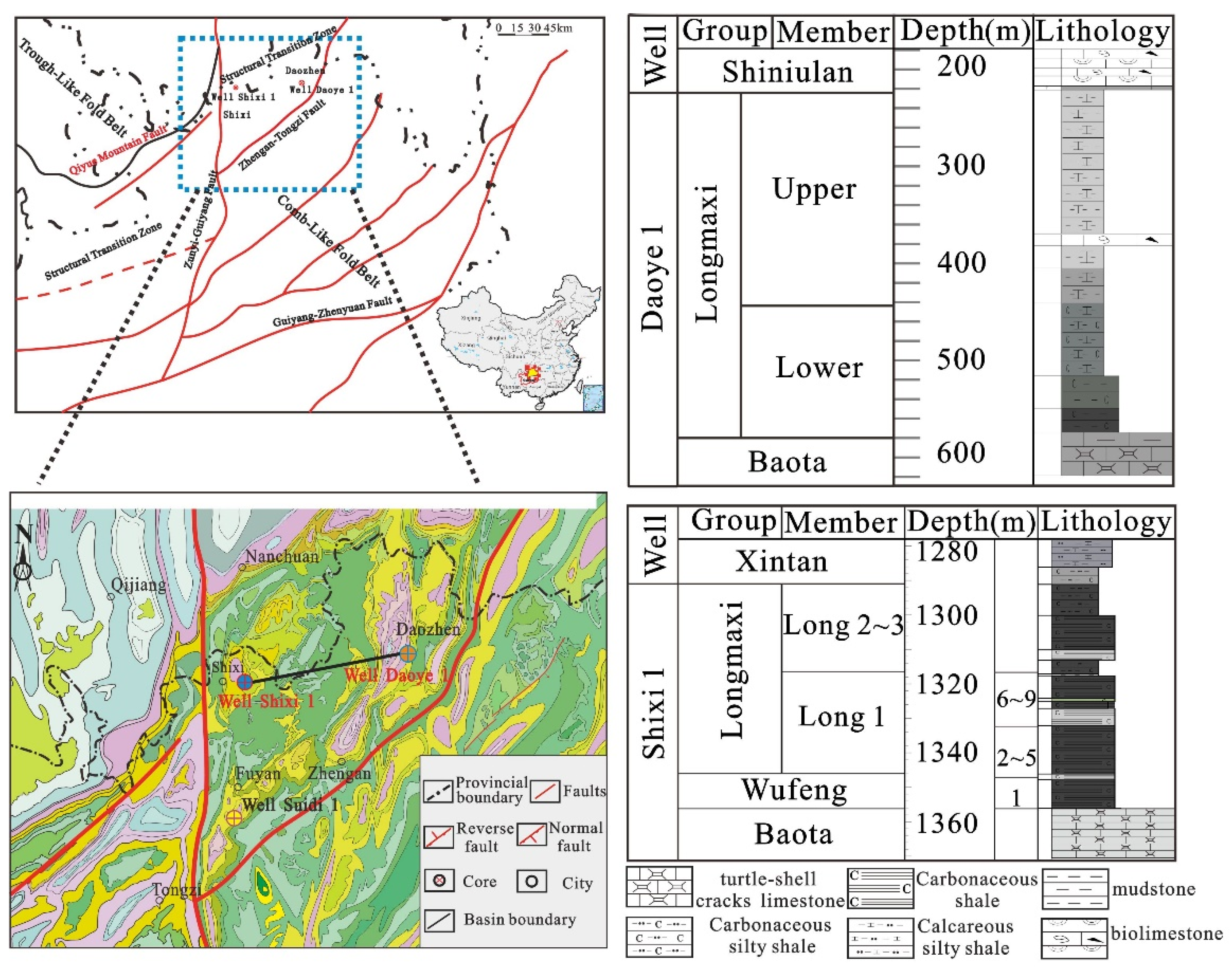
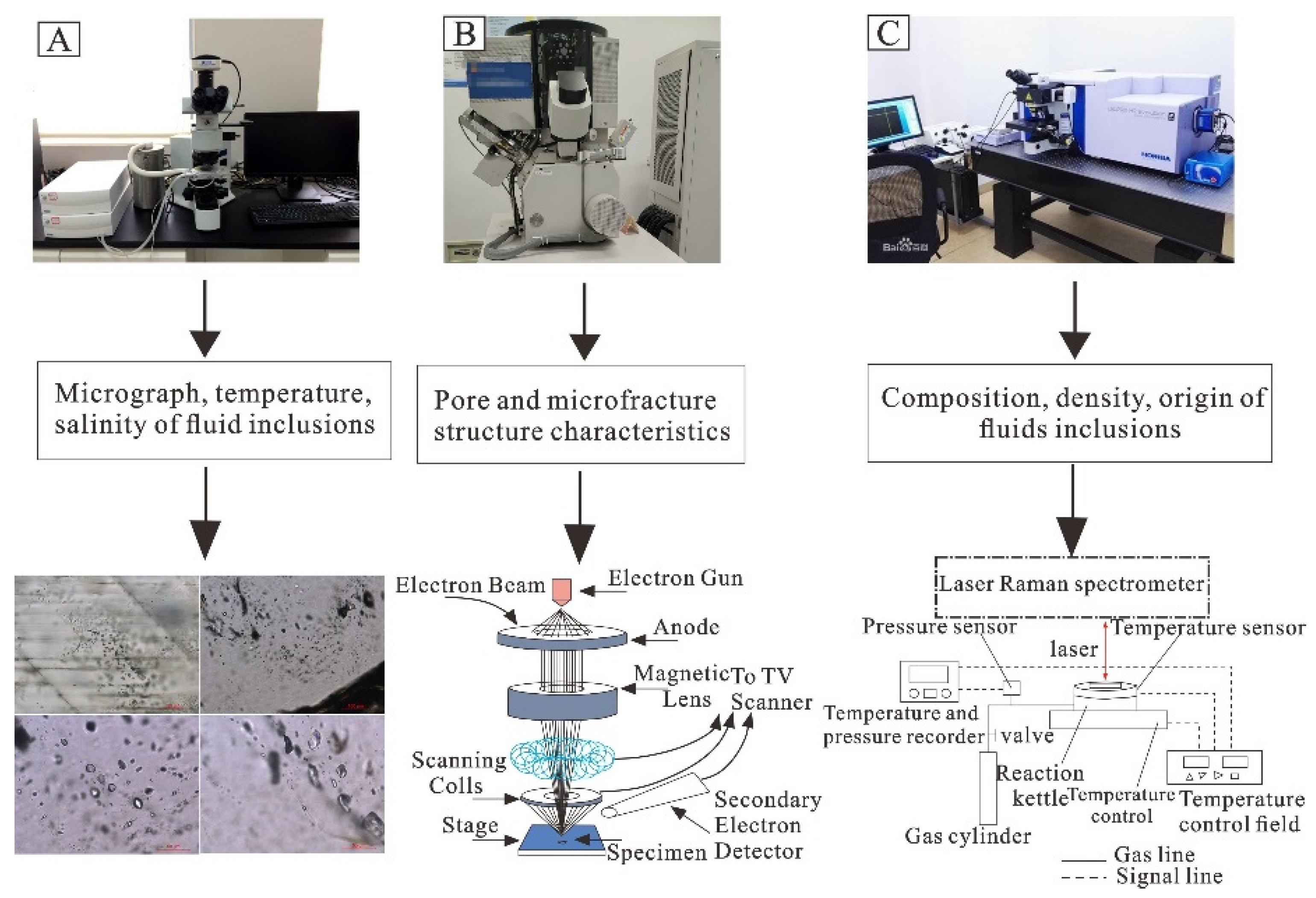
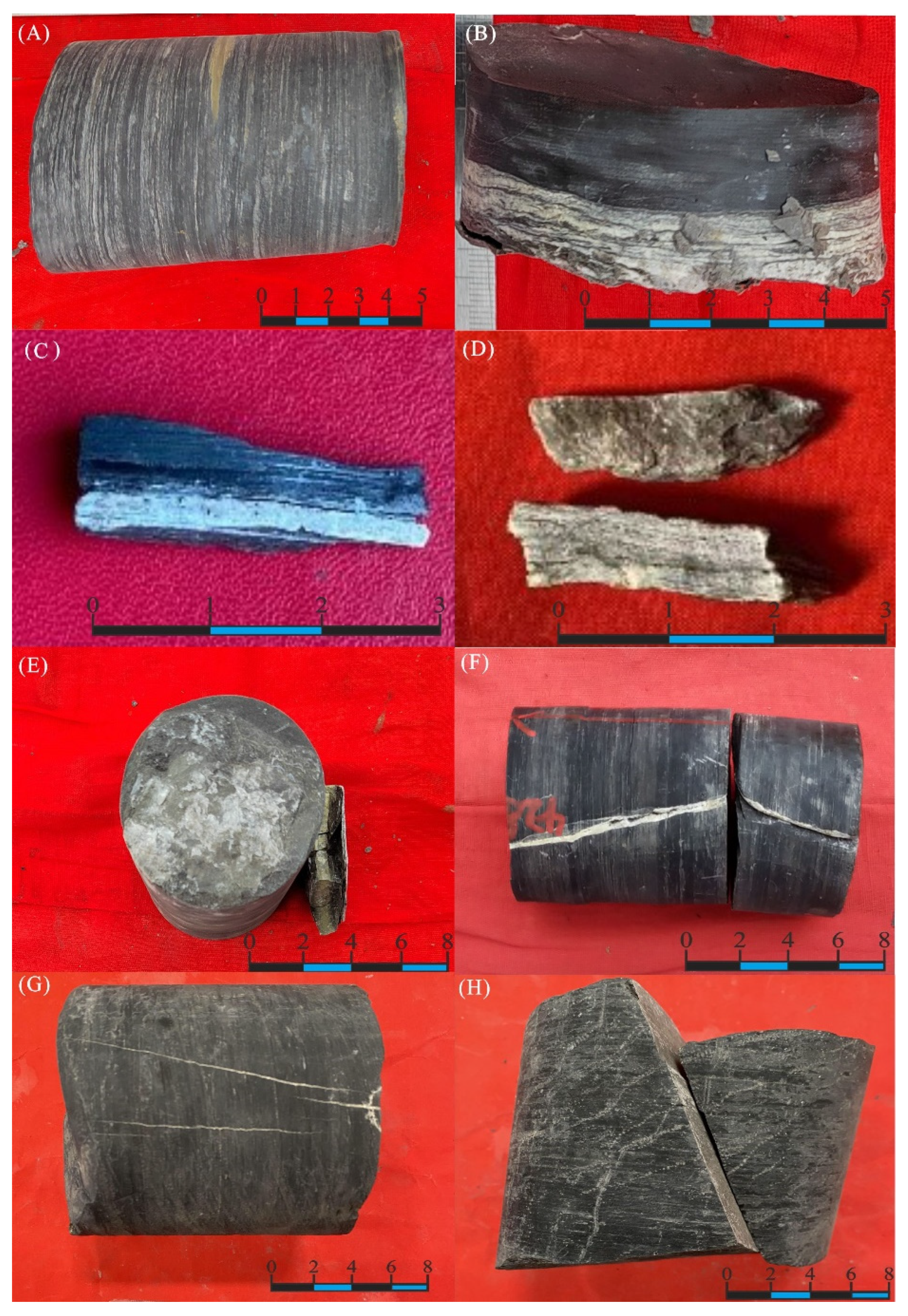
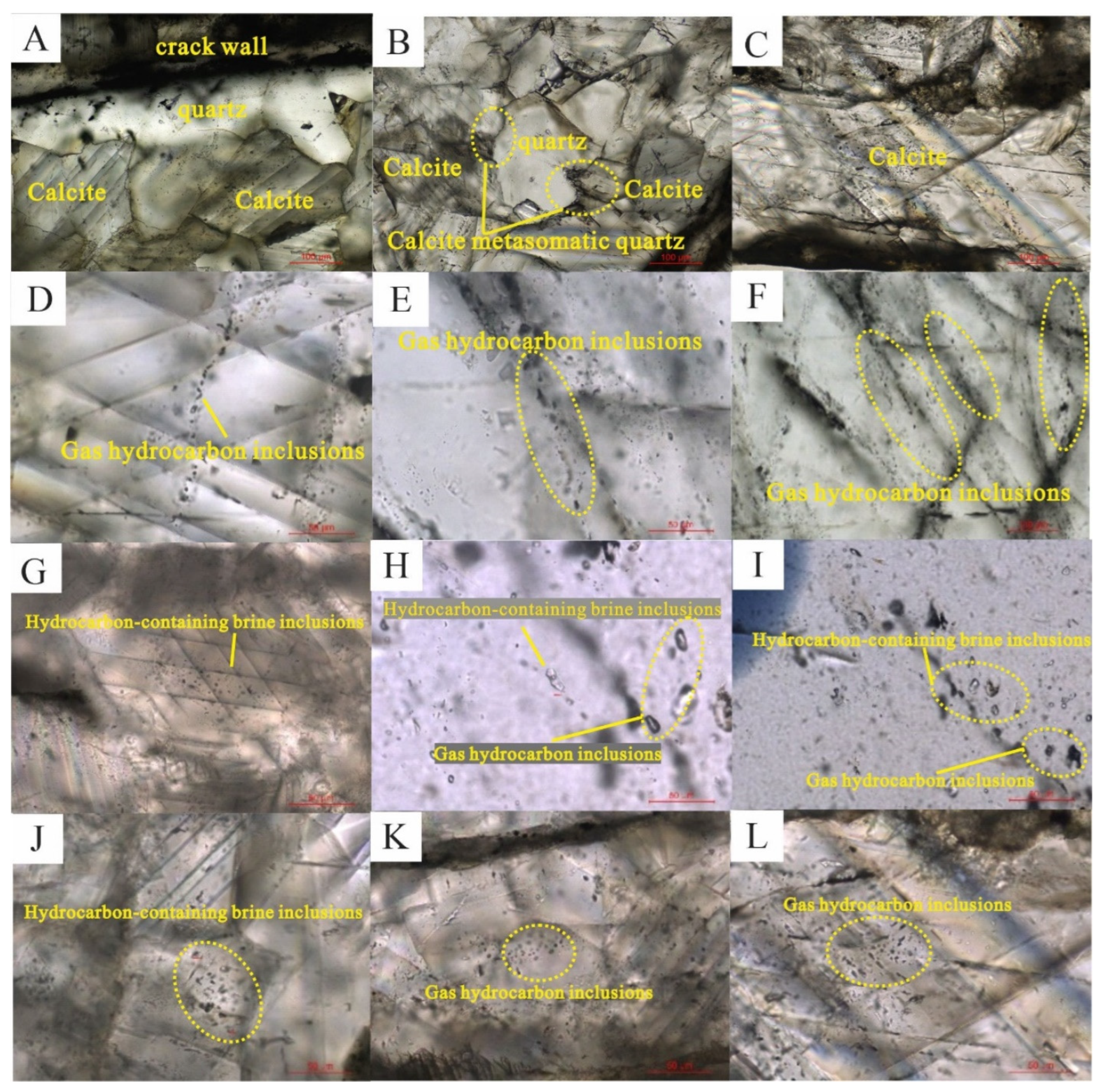
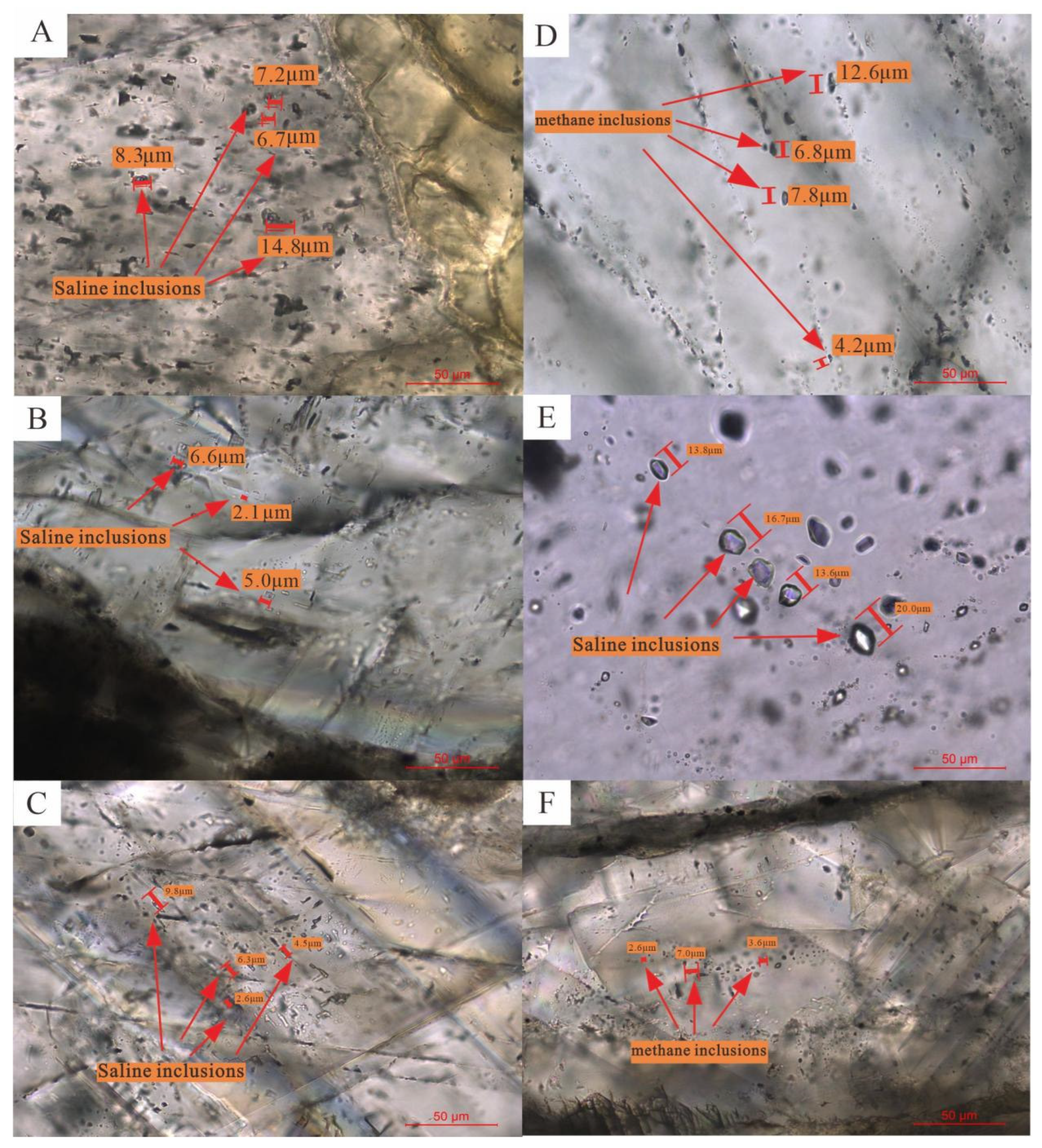
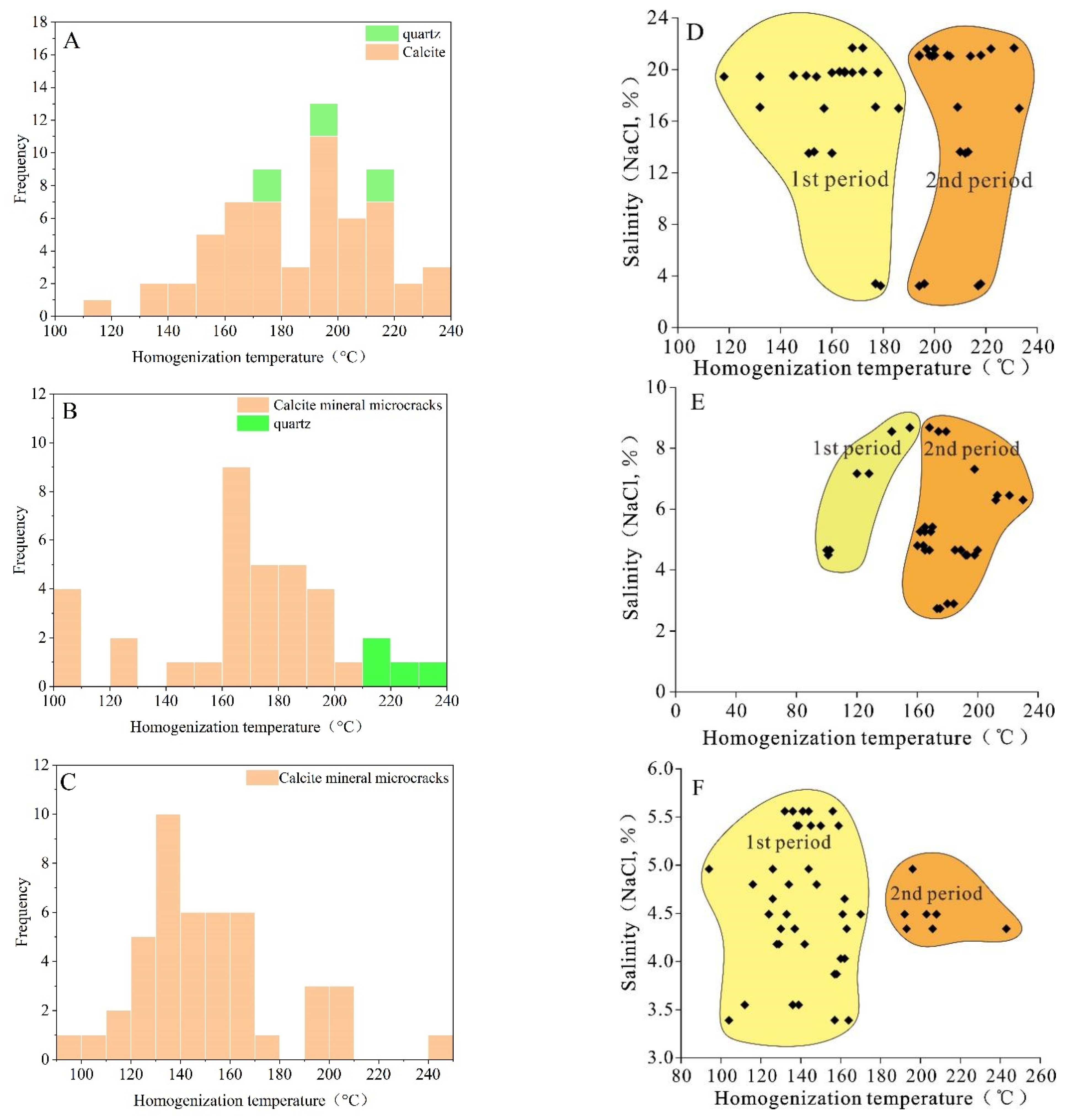
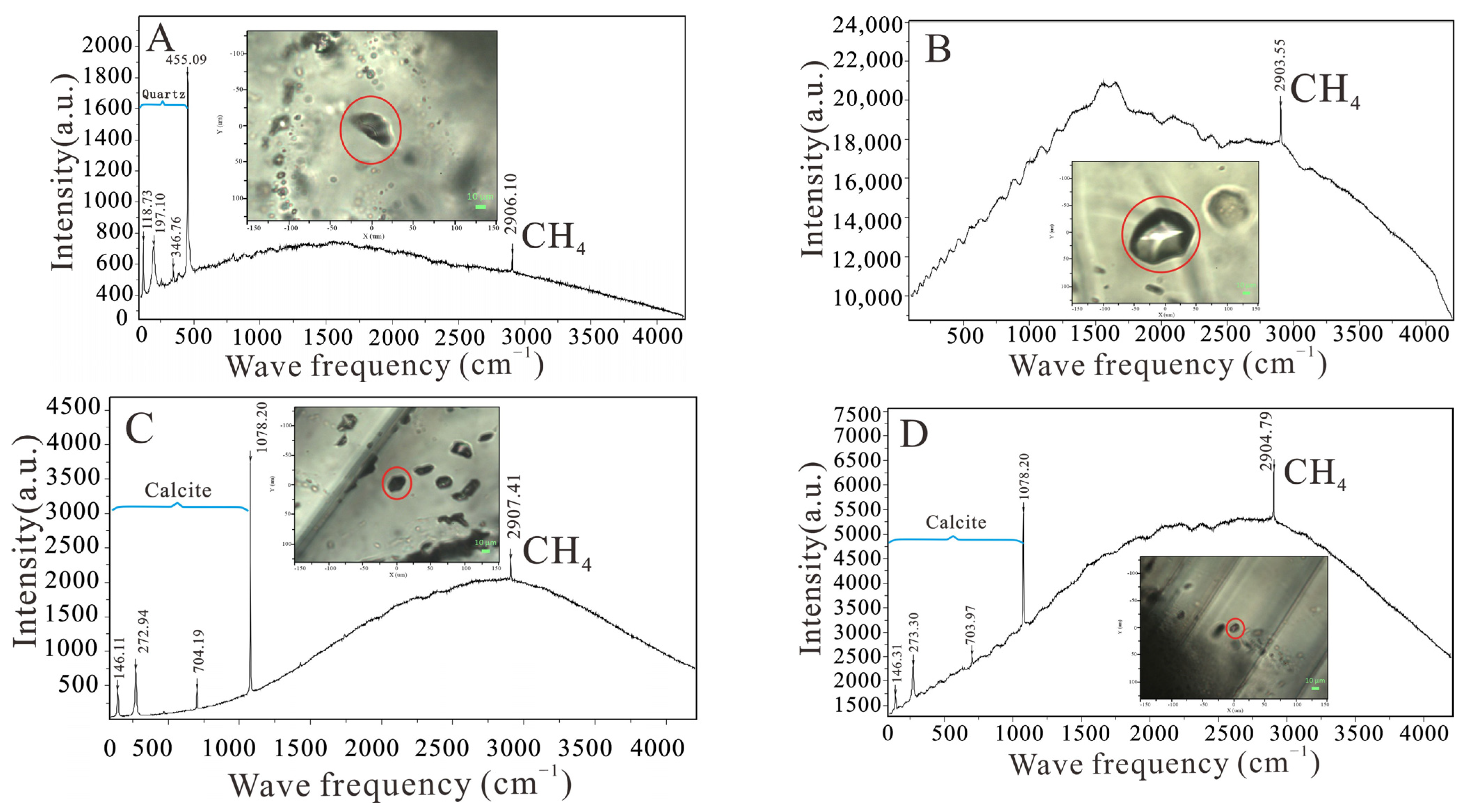
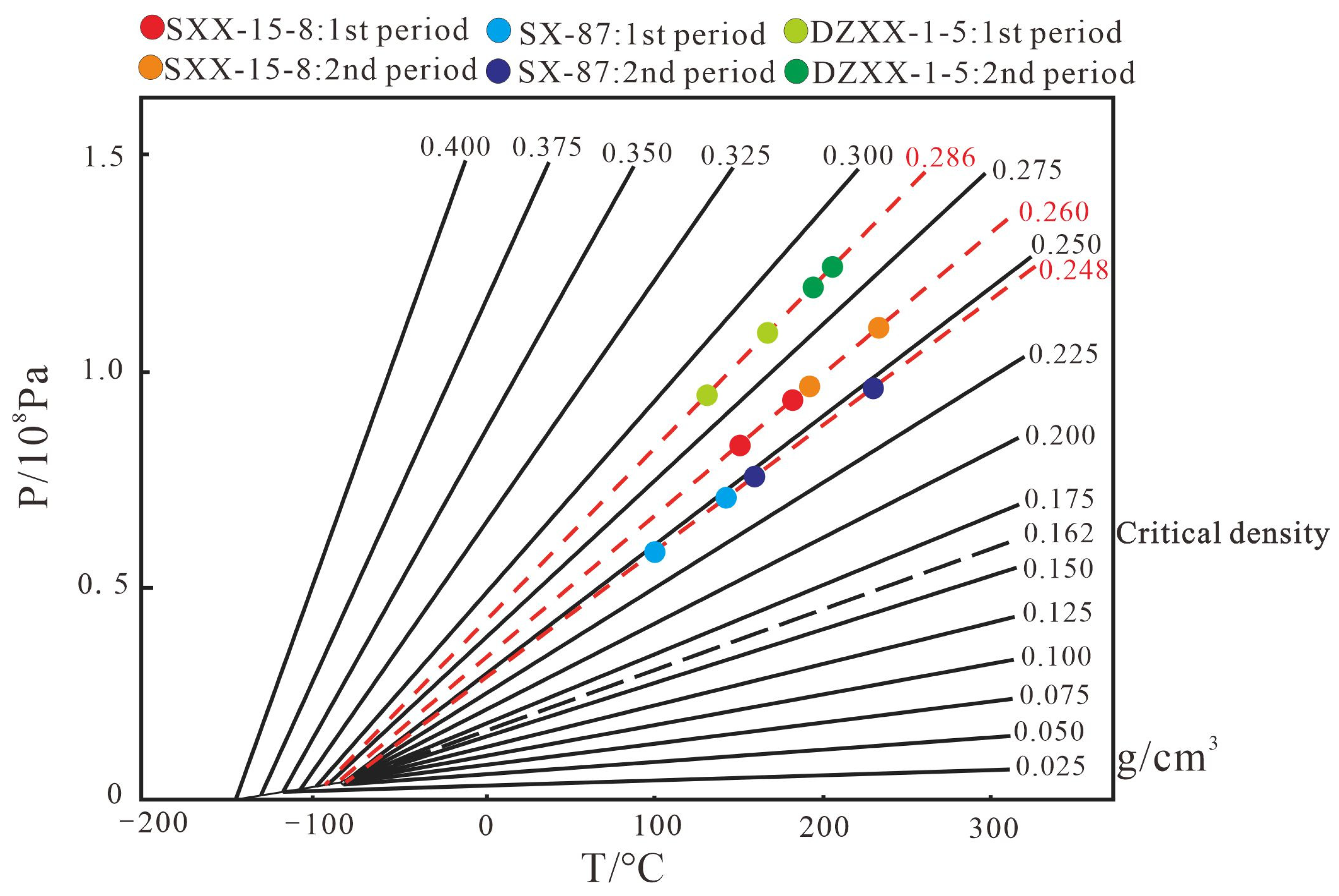
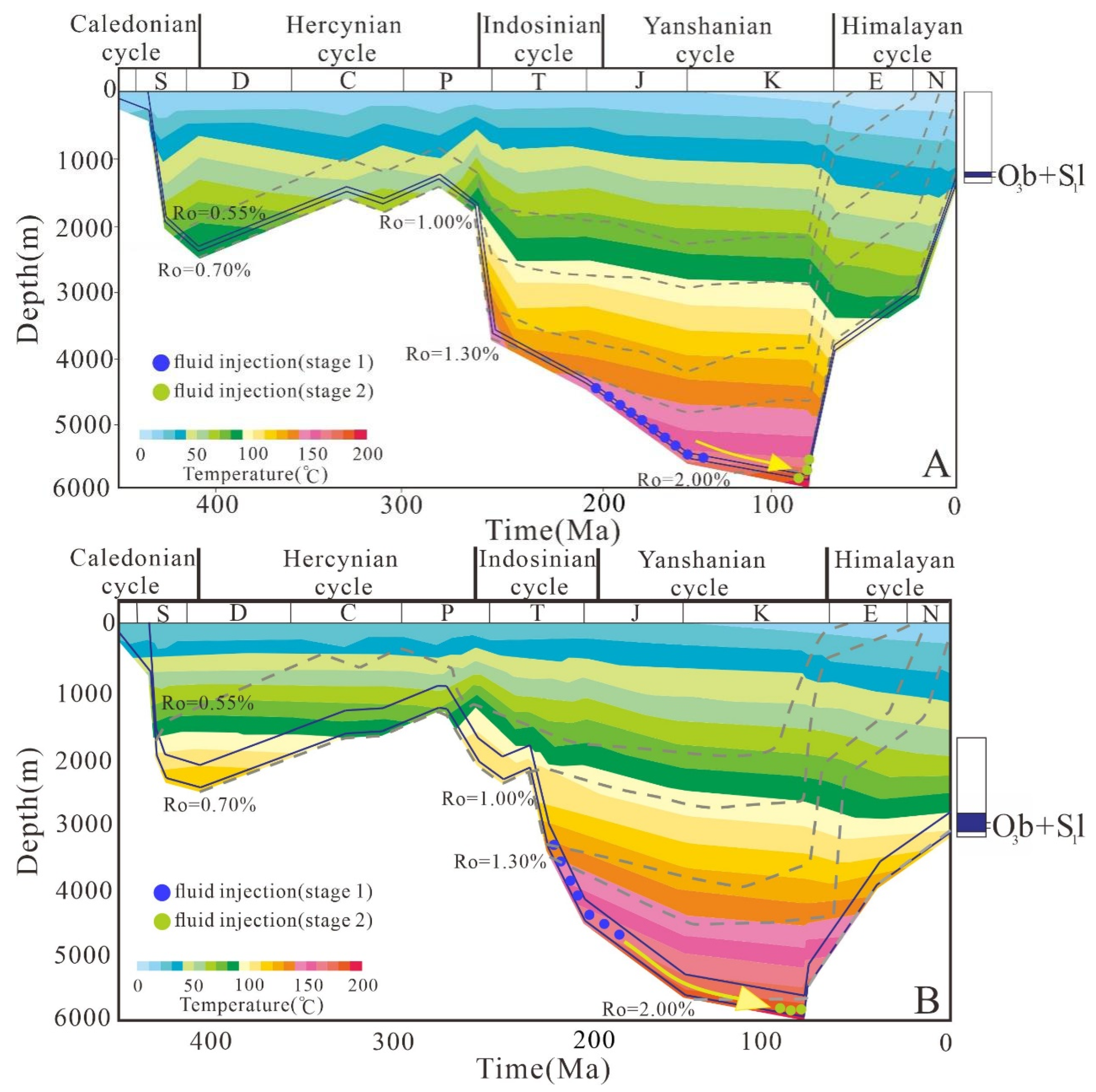
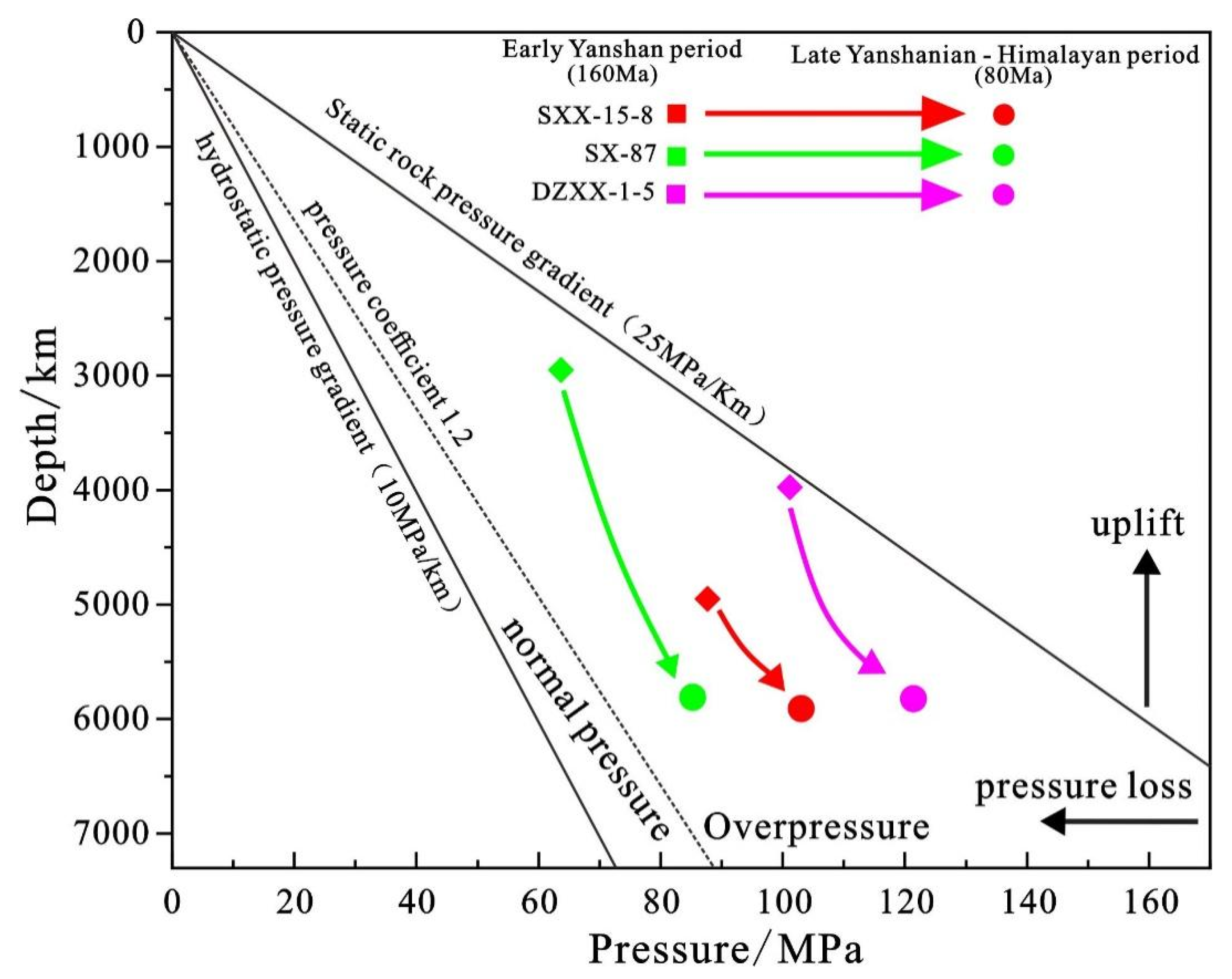
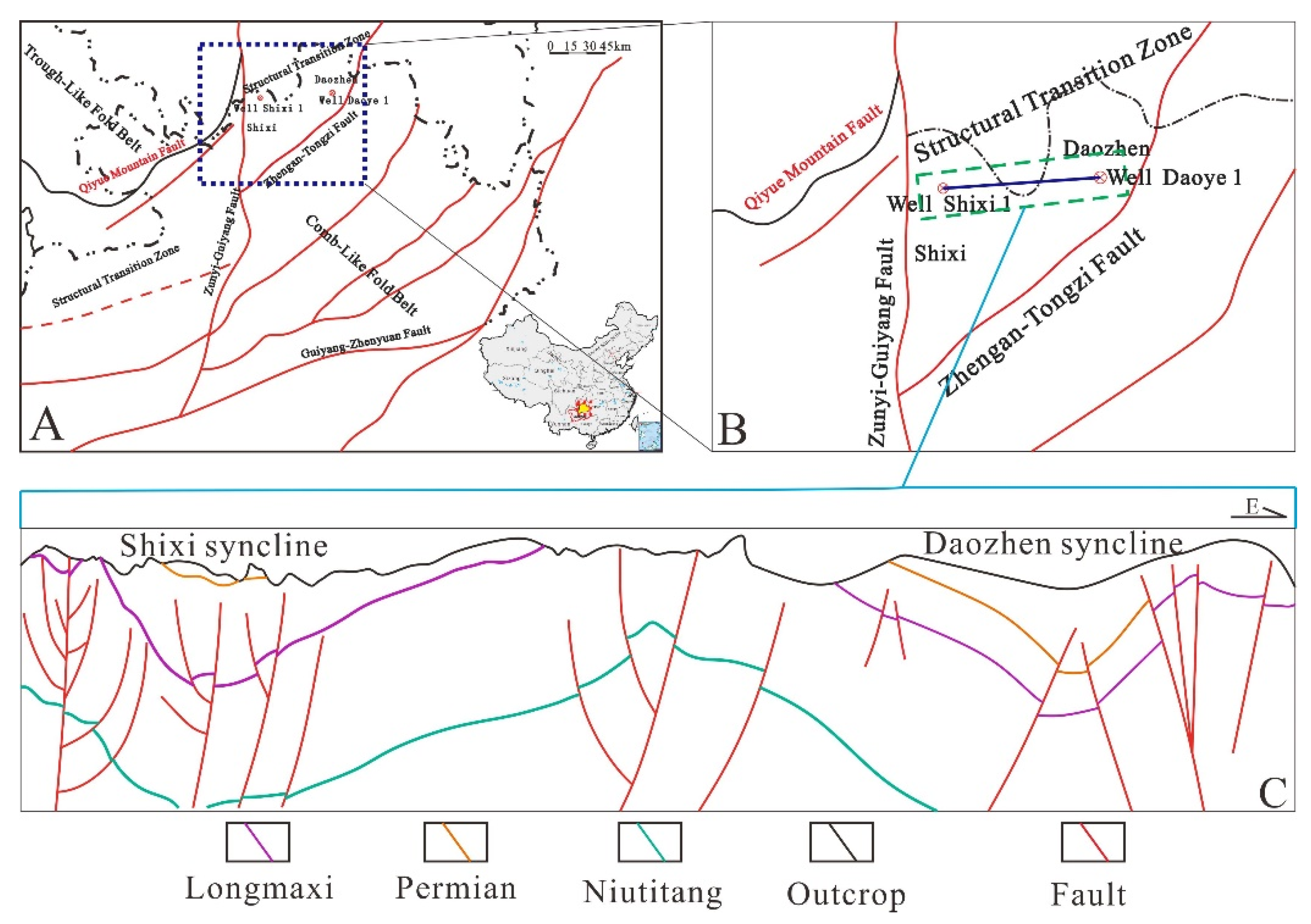
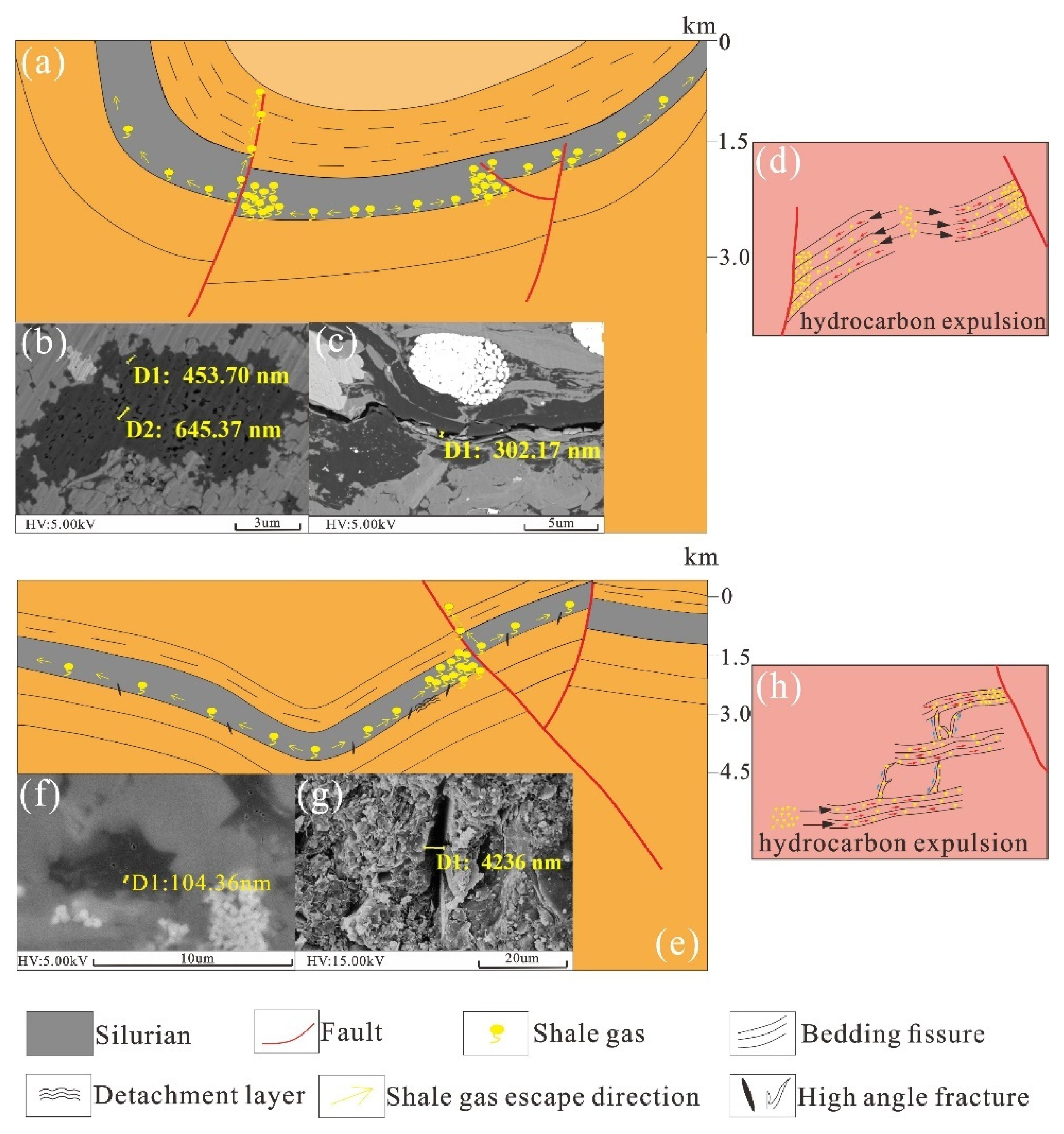
| Research Area (Syncline) | Structural Style | Burial Depth (m) | Target Layer Thickness Area (m) | Exposed Area of Triassic (km2) | Acute Angle Between the Principal Stress and Fracture Strike (°) | Stratigraphic Dip (°) | Distance from the Regional Fracture (km) |
|---|---|---|---|---|---|---|---|
| Shixi | Syncline core reverse fault blocking type | 1291.4~1351.7 | 28.98 | 30 | 75 | 0~14 | 1.32 |
| Daozhen | reverse fault blocking type | 489.0~597.1 | 27.86 | — | 50 | 4~27 | 2.09 |
| Zhongguan | Normal fault destructive type | 1080.8~1121.6 | 21 | 23.1 | — | 11~44 | 1.5 |
| Fuyan | 1131.2~1141.8 | 10 | 49.7 | 45 | 49 | 0.92 |
Disclaimer/Publisher’s Note: The statements, opinions and data contained in all publications are solely those of the individual author(s) and contributor(s) and not of MDPI and/or the editor(s). MDPI and/or the editor(s) disclaim responsibility for any injury to people or property resulting from any ideas, methods, instructions or products referred to in the content. |
© 2023 by the authors. Licensee MDPI, Basel, Switzerland. This article is an open access article distributed under the terms and conditions of the Creative Commons Attribution (CC BY) license (https://creativecommons.org/licenses/by/4.0/).
Share and Cite
Li, X.; Du, W.; Feng, X.; Shi, F.; Chen, Y.; Wang, Y.; Jiang, Z.; Luo, Q. Pressure Evolution Mechanism of Marine Shale Reservoirs and Shale Gas Accumulation Model: Evidence from Fluid Inclusions in the Wufeng–Longmaxi Formation in the Basin Margin Structural Transition Zone in Northern Guizhou Province, China. Minerals 2023, 13, 241. https://doi.org/10.3390/min13020241
Li X, Du W, Feng X, Shi F, Chen Y, Wang Y, Jiang Z, Luo Q. Pressure Evolution Mechanism of Marine Shale Reservoirs and Shale Gas Accumulation Model: Evidence from Fluid Inclusions in the Wufeng–Longmaxi Formation in the Basin Margin Structural Transition Zone in Northern Guizhou Province, China. Minerals. 2023; 13(2):241. https://doi.org/10.3390/min13020241
Chicago/Turabian StyleLi, Xingyu, Wei Du, Xia Feng, Fulun Shi, Yi Chen, Yisong Wang, Zhenxue Jiang, and Qun Luo. 2023. "Pressure Evolution Mechanism of Marine Shale Reservoirs and Shale Gas Accumulation Model: Evidence from Fluid Inclusions in the Wufeng–Longmaxi Formation in the Basin Margin Structural Transition Zone in Northern Guizhou Province, China" Minerals 13, no. 2: 241. https://doi.org/10.3390/min13020241
APA StyleLi, X., Du, W., Feng, X., Shi, F., Chen, Y., Wang, Y., Jiang, Z., & Luo, Q. (2023). Pressure Evolution Mechanism of Marine Shale Reservoirs and Shale Gas Accumulation Model: Evidence from Fluid Inclusions in the Wufeng–Longmaxi Formation in the Basin Margin Structural Transition Zone in Northern Guizhou Province, China. Minerals, 13(2), 241. https://doi.org/10.3390/min13020241






